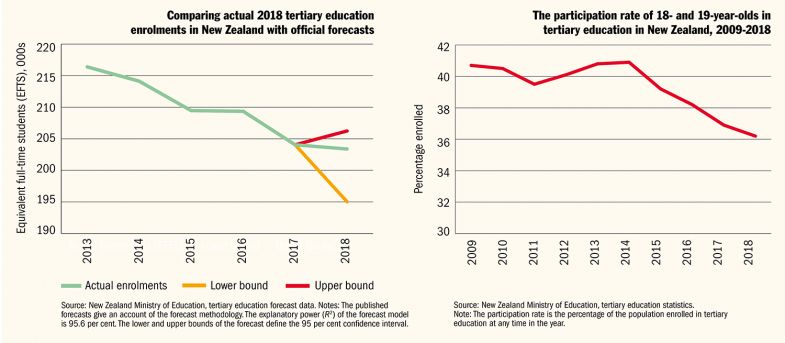He also notes that if we take seriously survey results from Canterbury Uni, where 5.8% of students said that fees-free was critical to their decision to enrol (and we perhaps might think that an overestimate), it would still mean that taxpayers had to fund the fees of 47,000 students to enable 2,700 enrolments across the system in 2018.So how did the first stage in the fees-free policy work out in New Zealand?Let’s look at the 2018 New Zealand tertiary education enrolments data and compare them with the government’s forecasts for 2018. Those forecasts – based on enrolment trends up to 2017, demographic data and predictions about the labour market – took no account of the fees-free policy. This means we can compare the actual enrolments in 2018 with what was expected in the absence of the fees-free policy. From this, we can estimate the effect on enrolments of the policy change.
Student enrolments in New Zealand across time
The actual 2018 outcome is within the 95 per cent confidence interval for the forecast – within the margin of error. In other words, the actual result was in line with what would have been expected in the absence of the fees-free policy. That means there was no statistically measurable effect on enrolments from the change in policy. None at all.Another test of the impact of the fees-free policy is to look at the population aged 18 and 19 – the age group most likely to be affected – and to ask what happened to their participation rates. Figure 3 above shows the proportion of the population aged 18 to 19 who were enrolled in tertiary education over the past 10 years.The trend in the participation rate reflects the labour market. Youth unemployment remained relatively high in New Zealand in the years following the global financial crisis. But, as the youth labour market began to strengthen after 2013, the enrolment rate began to drop. Fees have much less effect on enrolments than employment factors. The tertiary participation rate continued to fall in 2018, despite the fees-free policy.If the government were to judge the success of the policy on how it lifted access to post-secondary education, it would have to give itself a fail grade. The report card might read: “Tried hard but made many basic errors.”
Smyth's piece over at Ed Central is also well worth a read.
So how should the government target its spending better? How should it address problems in access to tertiary education?An excellent 2018 report, by Ministry of Education researcher, David Earle, is the most comprehensive and rigorous study yet of access to tertiary education in New Zealand. It provides a blueprint for what not to do to address barriers to access.The study analysed participation in post-school education across an entire birth cohort, using Statistics New Zealand’s integrated data infrastructure, which links anonymised data from the government agencies managing the education, tax, welfare, migration, employment, health and justice systems – data on ethnicity, school performance, school truancy, socio-economic status (SES), parental education, income, occupation and criminal record….Applying statistical techniques to control for all these variables, Earle has worked out which factors are associated with risk of non-participation in tertiary education at Level 4 or above.Unsurprisingly, he finds that achievement and performance at school dwarfs other factors. But after controlling for school performance, some other factors also play a part. For instance, people whose parents have higher qualifications are more likely to enter tertiary education at Level 4 or above. Students who grow up in more deprived neighbourhoods are less likely to enrol, even once other factors are controlled for. Māori are less likely than the general population to go on to higher education, even if they have done well at school. People who use mental health services are less likely to advance to higher levels of education.However, many of the dozens of other variables tested in this study have no significant influence on participation in higher education once school performance is taken into account. These include parental income, truancy and family transience.The inference from Earle’s research is that interventions that target factors shown to be not statistically significant should be quietly set aside. For instance, given that parental income wasn’t found to be significant, interventions directed at lifting participation of young people from low-income families by reducing costs are not likely to work, given current student support policies. It’s no surprise that a financially-focused access initiative – like the current fees-free policy – had minimal effect on participation.What this suggests is that access initiatives should focus on lifting school achievement among those groups which the research shows are less likely to participate – those raised in low SES areas, Māori, those whose families have lower educational achievement. The University of Auckland’s StarPath programme, with its emphasis on improving school achievement through changing practices in lower decile secondary schools, is an example of an intervention that targets the right things.That’s a quite different form of intervention. It’s not as straightforward as removing fees. It may take longer. It might attract less notice and generate fewer votes. But it might just work.


No comments:
Post a Comment